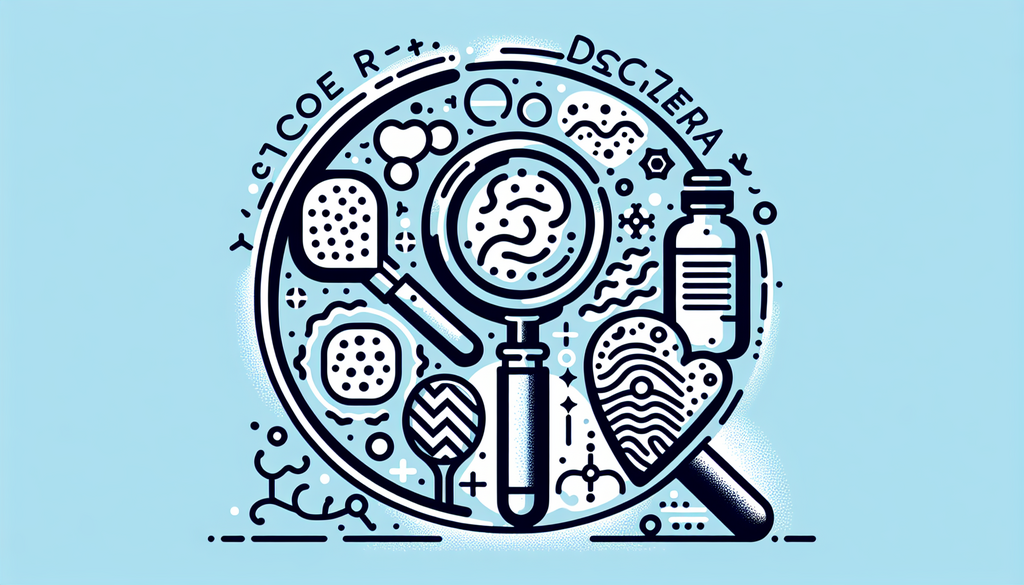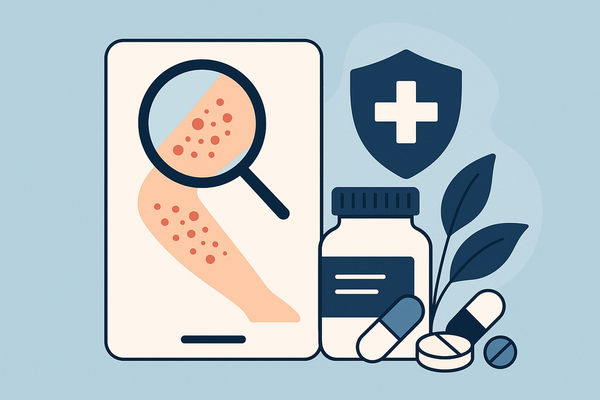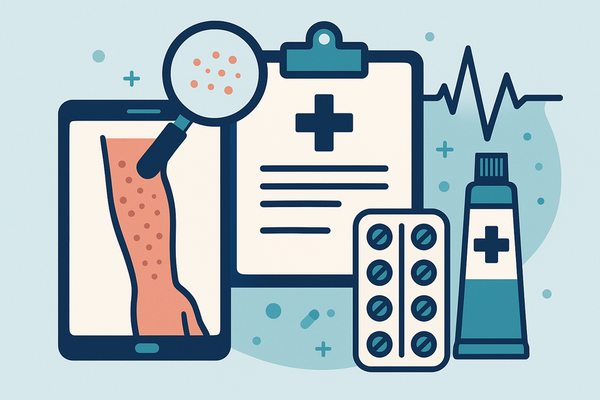Eczema vs Psoriasis Rash: How to Differentiate Common Chronic Skin Disorders
Discover how to differentiate eczema vs psoriasis rash. Learn about symptoms, treatments, and management strategies for effective care.

Estimated reading time: 8 minutes
Key Takeaways
- Eczema and psoriasis are chronic inflammatory skin disorders with overlapping and distinct features.
- Eczema presents with intense itching, poorly defined borders, and triggers like irritants.
- Psoriasis features well-defined plaques, silvery-white scales, and autoimmune triggers.
- Accurate diagnosis via history, exam, and sometimes biopsy is essential.
- Treatment options include topical agents, phototherapy, and systemic therapies tailored to each condition.
- Differentiate from seborrheic dermatitis, rosacea, lichen planus, and other chronic itchy rashes.
- Seek medical advice for persistent, severe, or unclear rashes.
Table of Contents
- Introduction
- Section 1: Detailed Discussion on Eczema vs Psoriasis Rash
- What Is Eczema? Defining Atopic Dermatitis
- What Is Psoriasis? Understanding the Autoimmune Rash
- Similarities, Differences & Diagnostic Challenges
- Treatment & Management Strategies
- Section 2: Exploring Seborrheic Dermatitis on Scalp
- Section 3: Understanding Rosacea Rash on Face
- Section 4: Identifying Lichen Planus Symptoms
- Section 5: Addressing Chronic Itchy Rash No Cure
- Section 6: Comparative Summary
- Section 7: Conclusion & Recommendations
- FAQ
Introduction
Understanding eczema vs psoriasis rash is vital because misdiagnosis can lead to ineffective treatments. Persistent skin disorders are chronic, relapsing rashes that impair quality of life and may require lifelong management. For location-specific guidance, see our posts on common back rashes and arm rashes. In this post, we’ll compare these two conditions alongside seborrheic dermatitis on scalp, rosacea rash on face, lichen planus symptoms, and chronic itchy rash no cure.
Section 1: Detailed Discussion on Eczema vs Psoriasis Rash
What Is Eczema? Defining Atopic Dermatitis
Eczema vs psoriasis rash often starts with atopic dermatitis, a group of inflammatory skin diseases driven by immune dysregulation.
- Intense itching, often severe (intense itching)
- Red, dry, scaly patches; possible oozing blisters and crusting during flares
- Common triggers: environmental irritants (soaps, fragrances), allergens, stress, rough fabrics
Real-world note: In my clinic, patients report night-time scratching that disrupts sleep and worsens skin barrier damage.
What Is Psoriasis? Understanding the Autoimmune Rash
Psoriasis is an autoimmune rash marked by rapid skin cell turnover and plaque formation.
- Well-defined, raised plaques with silvery-white scales
- Red to purple/gray patches depending on skin tone
- Mild-to-moderate itching, burning or stinging sensation
- Common triggers: stress, skin injury (Koebner phenomenon), infection, certain medications
Clinical insight: Phototherapy often slims plaques within weeks but requires controlled dosing to avoid burns.
Eczema vs Psoriasis Rash: Similarities, Differences & Diagnostic Challenges
| Feature | Eczema | Psoriasis |
|---|---|---|
| Itch intensity | Intense itching | Mild-burning discomfort |
| Border definition | Poorly defined | Well-defined |
| Scale type | Dry, scaly | Silvery-white, thick |
| Typical locations | Flexures, face, hands | Scalp, elbows, knees, back |
| Age of onset | Often childhood | Any age (adult onset common) |
| Triggers | Irritants/allergens | Trauma/infection/meds |
| Family history | Common | Common |
Diagnostic overlap occurs in atypical presentations (e.g., sebopsoriasis). A dermatologist evaluation including history, exam, and sometimes biopsy is essential for accurate diagnosis.
Treatment & Management Strategies
Eczema:
- Emollients and moisturizers (occlusives like petrolatum)
- Trigger avoidance (fragrance-free cleansers, soft fabrics)
- Topical corticosteroids (hydrocortisone to clobetasol)
- Topical calcineurin inhibitors (tacrolimus, pimecrolimus)
Psoriasis:
- Topical steroids (betamethasone)
- Vitamin D analogs (calcipotriene)
- Phototherapy (narrowband UVB)
- Systemic agents (methotrexate, cyclosporine, biologics)
Patient tip: Rotate topical therapies under physician guidance to reduce tachyphylaxis.
Section 2: Exploring Seborrheic Dermatitis on Scalp
Definition & Pathogenesis: Seborrheic dermatitis on scalp is a chronic inflammatory disorder affecting sebum-rich areas, linked to Malassezia yeast overgrowth and immune response.
Symptoms: Yellowish, greasy scales with underlying redness; persistent flaking or dandruff; mild itching. Severe cases show thick white/yellow crusts.
Clinic note: Patients often confuse scalp psoriasis with stubborn dandruff; microscopic KOH can reveal yeast.
Section 3: Understanding Rosacea Rash on Face
What Is Rosacea? A chronic inflammatory condition of the central face with erythema, telangiectasia, papules, and pustules.
Triggers: Sun, spicy foods, alcohol, temperature extremes, stress. Symptoms include flushing, persistent redness, visible blood vessels, burning/stinging.
Section 4: Identifying Lichen Planus Symptoms
Defining Lichen Planus: A T-cell–mediated attack on basal keratinocytes leading to purple, flat-topped, polygonal papules with Wickham’s striae. Common on wrists, ankles, and mucosa. Severe itching; lesions may persist for months to years.
Section 5: Addressing Chronic Itchy Rash No Cure
Why Some Rashes Have No Cure: Immune dysregulation or genetic factors prevent permanent eradication; focus is on symptom control and maintaining remission.
- Symptom control: regular moisturizers, topical therapies, medicated shampoos
- Trigger avoidance: identify personal flare triggers
- Stress management: mindfulness, CBT to reduce flares
- Systemic treatments: reserved for severe, refractory cases
Section 6: Comparative Summary
Key differentiators among chronic skin rashes include differences in border definition, scale type, itch intensity, distribution, triggers, and treatment approaches. Recognizing these helps clinicians and patients target therapies effectively.
Section 7: Conclusion & Recommendations
Chronic skin rashes share overlapping features but differ in appearance, distribution, triggers, and treatments. Recognizing eczema vs psoriasis rash early and distinguishing it from seborrheic dermatitis on scalp, rosacea rash on face, lichen planus symptoms, or other chronic itchy rashes ensures targeted therapy and better quality of life. Always seek professional diagnosis for persistent or severe rashes.
When to Seek Medical Advice:
- Rash unresponsive to over-the-counter care for 2–4 weeks
- Rapid spread, painful cracks, bleeding, or infection
- Systemic symptoms (fever, joint pain) or quality-of-life impact
- Unclear diagnosis despite self-care efforts
For a quick, AI-powered evaluation of your rash, try Rash Detector, which analyzes photos and provides an initial report in seconds.

FAQ
- What are the main differences between eczema and psoriasis?
Eczema typically causes intense itching and poorly defined, dry patches, while psoriasis features well-defined, silvery-white plaques with milder itching. - Can I have both eczema and psoriasis?
Yes, some patients experience overlapping symptoms—a condition known as “sebopsoriasis”—necessitating tailored management. - How is eczema diagnosed?
Diagnosis is clinical, based on history, appearance, and sometimes patch testing or biopsy to rule out mimics. - Are there cures for chronic eczema or psoriasis?
Neither condition has a cure. Treatments focus on symptom control, reducing flares, and improving quality of life. - When should I see a dermatologist?
Seek professional advice for rashes that persist beyond 2–4 weeks, worsen despite treatment, or cause significant discomfort or impact your daily life.





